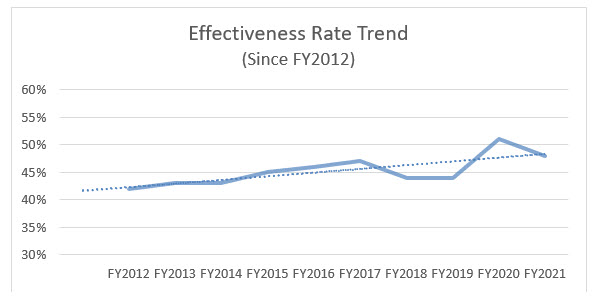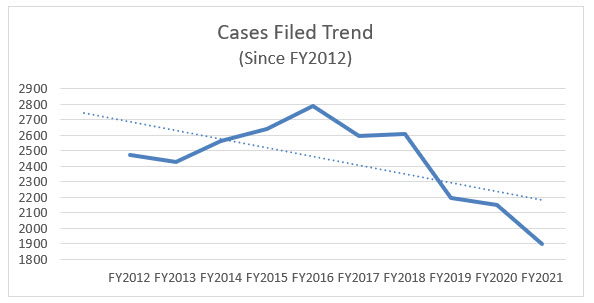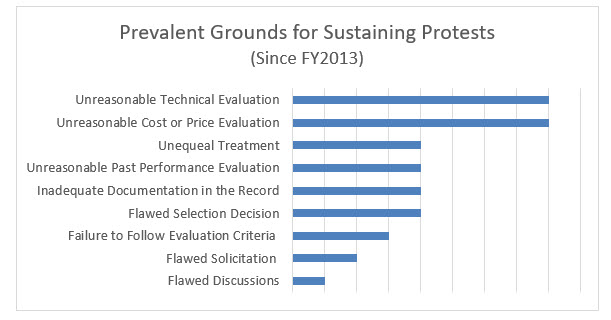KEY TAKEAWAYS
- GAO's Effectiveness Rate remains high, demonstrating that protesters obtain relief in nearly 50% of all bid protest filings.
- For protests that reach a final merits decision, GAO's sustain rate remained steady at 15%
- For the first time, GAO identified "flawed discussions" as one of the most prevalent reasons for sustaining protests.
The Government Accountability Office ("GAO") recently released its Annual Report to Congress for the Fiscal Year 2021. The report shows that, while the total number of bid protests dropped significantly in FY2021, nearly half of all protests filed at GAO enjoyed some level of relief.
In the chart below, we summarize GAO's most recent release of its bid protest statistics for the past five fiscal years:

The Annual Report reflects that GAO had yet another active year of protest activity. Below are a few key observations:
1. Effectiveness Rate Remains High: Protesters continue to enjoy a relatively high success rate, as reflected by GAO's Effectiveness Rate. This measures the rate at which a protester obtains some form of relief at GAO, including voluntary corrective action or a sustained protest. While the Effectiveness Rate dipped slightly to 48% in FY2021 from 51% in FY2020, the historical trend reflects that the Effectiveness Rate has generally increased throughout the past ten years (as reflected in the chart below):

The Effectiveness Rate for FY2021 continues a remarkable positive trend, with the ten-year average coming in at approximately 45%. The fact that nearly half of all protest filings achieve some level of success illustrates that protests continue to be an effective tool for contractors in competitive procurements.
2. Bid Protest Filings Drop Significantly: GAO's bid protest statistics have demonstrated a notable steadiness over the years. One major exception is the continued downward trend in the total number of protest filings. Since FY2018, the total filings dropped by 27%. This continues a year-over-year decrease in total filings after a peak in FY2016 (as reflected in the chart below):

The total filings in FY2021 is the lowest in thirteen years, when FY2008 saw only 1,652 filings. The drop in filings over the past two years may be attributed to the lingering impact of the COVID-19 pandemic, which continues to affect contractors' litigation and protest strategies. We also continue to see increased use of enhanced debriefing techniques for Department of Defense procurements. These enhanced debriefing techniques tend to provide contractors additional insight into the agency's evaluation and award decision, thus generally leading to fewer protests.
3. Familiar Grounds for Sustaining Protests: Each year, GAO highlights the "Most Prevalent Grounds for Sustaining Protest." In FY2021, the most common bases were: (i) unreasonable technical evaluation; (ii) flawed discussions; (iii) unreasonable cost or price evaluation; and (iv) unequal treatment. These reasons generally align with GAO's top reasons for sustaining protests since FY2013 (as reflected in the chart below):

It comes as no surprise that protesters continue to challenge, and GAO demonstrates a willingness to scrutinize, a procuring agency's technical and cost/price evaluations. However, it is noteworthy that FY2021 is the first year in which GAO considered "flawed discussions" to be one of the most prevalent reasons leading to a sustained bid protest. This serves as an important reminder to contractors that when a procuring agency conducts discussions during a competitive procurement, they must follow the procedures set forth in FAR Part 15.
Subscribe to get our Insights delivered to your inbox.
This publication is designed to provide general information on pertinent legal topics. The statements made are provided for educational purposes only. They do not constitute legal or financial advice nor do they necessarily reflect the views of Holland & Hart LLP or any of its attorneys other than the author(s). This publication is not intended to create an attorney-client relationship between you and Holland & Hart LLP. Substantive changes in the law subsequent to the date of this publication might affect the analysis or commentary. Similarly, the analysis may differ depending on the jurisdiction or circumstances. If you have specific questions as to the application of the law to your activities, you should seek the advice of your legal counsel.